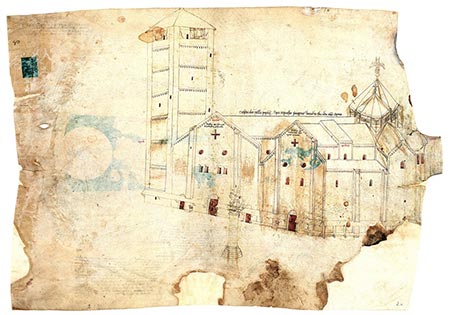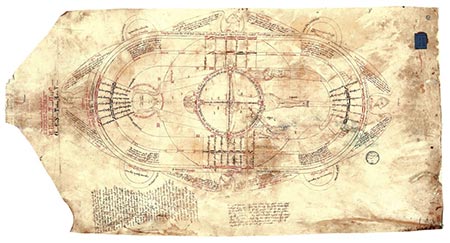
Passing through the Met’s Pen and Parchment: Drawing in the Middle Ages show this week, I was thrilled to discover a new fascination: the works of Opicinus de Canistris, a 14th-century Pavian who worked in the papal court in Avignon, France. According to the accompanying text, he survived a traumatic sickness, after which “he worked obsessively to develop and convey his unique understanding of the divine order through pictures.” His images are highly diagrammatic, and therefore metaphysical, while also being intensely personal. “They represent,” says the same panel, “an extraordinary instance of drawing used in the Middle Ages as a medium of intensely personal self-expression, even if in service to the divine.”
Wait—even if?

The first page of an article on JSTOR about a newly discovered manuscript of his (newly in 1953) expands on this personal dimension:
By far the most interesting part of this manuscript is a plate containing very full autobiographical notes covering the first forty years of the author’s life (Pl. 12), a rare piece from an age not rich in autobiographies. The notes are presented in a most peculiar arrangement: they are inscribed into a scheme of forty concentric rings each of which corresponds to one year in the author’s life. A calendar ring surrounding the whole system gives every single day its fixed place within the scheme. With remarkable precision, often verified by documentary material available elsewhere, the author has registered the events of his life in their chronologically correct place.

What grabs me so wildly about these pieces is precisely that sense in which everything has its right place in the cosmos. Ancient zodiacs combine with medieval ecclesiology, mixed together in the muddle of personal eccentricity. The images are so foreign, so strange to unaccustomed eyes, yet something quite like them can be found in the imagination of at least one local character of a halfway interesting town nowadays, probably etching away at something in a cafe or the obscurity of a home. A few such creatures, by chance, become recognized by the likes of papacies. But usually, today, to have such a metaphysics, or any metaphysics at all, really, is a tick of insanity. In the show as a whole, these works don’t necessarily stand out for the fact of having a diagrammatic metaphysics, but solely for its extraordinary intricacy and confidence.

Back to “even if,” above. The curator suggests that the service of the divine stands in contrast to distinctly personal expression. As Jed Perl’s helpful review in The New Republic points out, the place of the personal has been a source of contention lately in the interpretation of pre-modern art, as scholars search for the familiar, narcissistic, secular subject they are so used to finding everywhere in the contemporary scene. Surely he or she is in there somewhere, the thinking goes, however much imprisoned in the strictures of a dogmatic Church, that fetter on the flourishing of truly secular humanity.
Opicinus’s creations, I think, insist on something different. That “intensely personal self-expression” need not be, is not, opposed to “service to the divine.” His personhood, rather, seems to have found its most necessary bearings in the divine idiom. Though who knows what the divine thinks of such doodling.